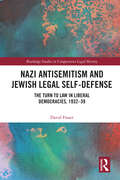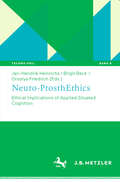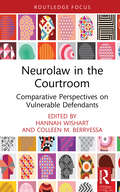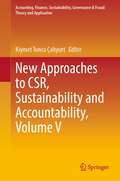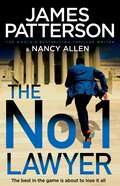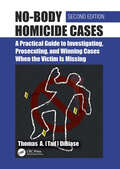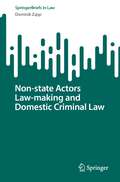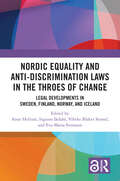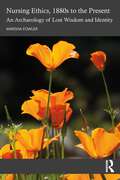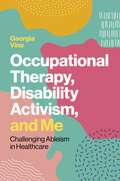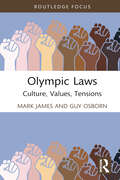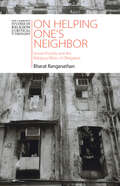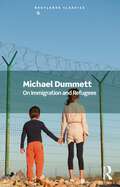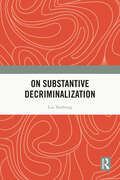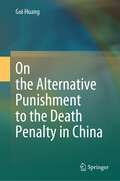- Table View
- List View
Nazi Antisemitism and Jewish Legal Self-Defense: The Turn to Law in Liberal Democracies, 1932–39 (Routledge Studies in Comparative Legal History)
by David FraserOne of the first to provide a socio-legal comparative history of under-studied or ignored Jewish attempts in the 1930s "Anglosphere" to counter the rise in fascist and Nazi antisemitism, this book examines the ways in which Jewish individuals and organized communal bodies in the mid-to-late 1930s sought to counter this increasing antisemitic violence, physical and verbal, by using the law against their fascist and Nazi attackers. This is the first study to explore how Jews in these countries organized themselves, brought their oppressors to court, while seeking to convince their governments that an attack on Jews was a threat to the social order. The book analyzes the networks of knowledge and the personal relationships between and among key actors and institutions of the "Antisemitic International." Nazi "nationalists" always participated in networks that transcended borders. Case studies from Canada, South Africa, the United Kingdom, and the United States, illustrate the ways in which different mechanisms of Jewish resistance were deployed throughout the mid-to-late 1930s. They embody significant concerns about the "turn to law" and the importance of litigation and legislation. Grounded in original archival research on three continents, the book examines the ways in which professional legal discourse about public order and democratic citizenship proffered by Jewish communities and individual Jews was countered by their Nazi opponents with legal and political arguments about "truth," "persecution," and Jewish perfidy. The book will be of interest to students, academics, and researchers working in the areas of Legal History, History, Jewish Studies, the study of Antisemitism, and the History of the far right, fascism and Nazism.
Nazi Antisemitism and Jewish Legal Self-Defense: The Turn to Law in Liberal Democracies, 1932–39 (Routledge Studies in Comparative Legal History)
by David FraserOne of the first to provide a socio-legal comparative history of under-studied or ignored Jewish attempts in the 1930s "Anglosphere" to counter the rise in fascist and Nazi antisemitism, this book examines the ways in which Jewish individuals and organized communal bodies in the mid-to-late 1930s sought to counter this increasing antisemitic violence, physical and verbal, by using the law against their fascist and Nazi attackers. This is the first study to explore how Jews in these countries organized themselves, brought their oppressors to court, while seeking to convince their governments that an attack on Jews was a threat to the social order. The book analyzes the networks of knowledge and the personal relationships between and among key actors and institutions of the "Antisemitic International." Nazi "nationalists" always participated in networks that transcended borders. Case studies from Canada, South Africa, the United Kingdom, and the United States, illustrate the ways in which different mechanisms of Jewish resistance were deployed throughout the mid-to-late 1930s. They embody significant concerns about the "turn to law" and the importance of litigation and legislation. Grounded in original archival research on three continents, the book examines the ways in which professional legal discourse about public order and democratic citizenship proffered by Jewish communities and individual Jews was countered by their Nazi opponents with legal and political arguments about "truth," "persecution," and Jewish perfidy. The book will be of interest to students, academics, and researchers working in the areas of Legal History, History, Jewish Studies, the study of Antisemitism, and the History of the far right, fascism and Nazism.
Neuro-ProsthEthics: Ethical Implications of Applied Situated Cognition (Techno:Phil – Aktuelle Herausforderungen der Technikphilosophie #9)
by Jan-Hendrik Heinrichs Birgit Beck Orsolya FriedrichThe volume focusses on the ethical dimensions of the technological scaffold embedding human thought and action, which has been brought to attention of the cognitive sciences by situated cognition theories. There is a broad spectrum of technologies co-realising or enabling and enhancing human cognition and action, which vary in the degree of bodily integration, interactivity, adaptation processes, of reliance and indispensability etc. This technological scaffold of human cognition and action evolves rapidly. Some changes are continuous, some are eruptive. Technologies that use machine learning e.g. could represent a qualitative leap in the technological scaffolding of human cognition and actions. The ethical consequences of applying situated cognition theories to practical cases had yet to find adequate attention and are elucidated in this volume.
Neurolaw in the Courtroom: Comparative Perspectives on Vulnerable Defendants (Routledge Contemporary Issues in Criminal Justice and Procedure)
by Hannah Wishart and Colleen M. BerryessaThis collection presents a comparative perspective on interdisciplinary issues that fall under the emerging field of Neurolaw. The chapters embrace distinct procedural and evidential issues in the courtroom for vulnerable defendants, such as immature defendants, mentally disordered offenders and unfit-to-plead defendants, through a neuroscientific lens. This view is informed by worldwide analyses from legal academics, philosophers, and legal practitioners. The work brings together interdisciplinary and leading perspectives to discuss the use and relevancy of neuroscience at trial, and how the use of neuroscience is currently benefiting and impacting vulnerable defendants in global criminal trials. As such, the book builds upon and adds to the existing literature in this field by providing a comprehensive coverage of the intersection between these disciplines for vulnerable defendants in the courtroom. Key issues covered include: vulnerable defendants and the pre-trial process; the trial process; the use of neuroscience as expert evidence at trial; and vulnerable defendants, neuroscience and mitigation of sentence. Through original exploration presented by contributors from both academia and practice, the book will be of interest to academics, researchers and policy-makers working in the areas of Criminal Law and Procedure.
Neurolaw in the Courtroom: Comparative Perspectives on Vulnerable Defendants (Routledge Contemporary Issues in Criminal Justice and Procedure)
This collection presents a comparative perspective on interdisciplinary issues that fall under the emerging field of Neurolaw. The chapters embrace distinct procedural and evidential issues in the courtroom for vulnerable defendants, such as immature defendants, mentally disordered offenders and unfit-to-plead defendants, through a neuroscientific lens. This view is informed by worldwide analyses from legal academics, philosophers, and legal practitioners. The work brings together interdisciplinary and leading perspectives to discuss the use and relevancy of neuroscience at trial, and how the use of neuroscience is currently benefiting and impacting vulnerable defendants in global criminal trials. As such, the book builds upon and adds to the existing literature in this field by providing a comprehensive coverage of the intersection between these disciplines for vulnerable defendants in the courtroom. Key issues covered include: vulnerable defendants and the pre-trial process; the trial process; the use of neuroscience as expert evidence at trial; and vulnerable defendants, neuroscience and mitigation of sentence. Through original exploration presented by contributors from both academia and practice, the book will be of interest to academics, researchers and policy-makers working in the areas of Criminal Law and Procedure.
New Approaches to CSR, Sustainability and Accountability, Volume V (Accounting, Finance, Sustainability, Governance & Fraud: Theory and Application)
by Kıymet Tunca ÇalıyurtThis book continues the discussion from the first four volumes on the challenges that organizations face in order to implement sustainability, ethics, and effective corporate governance, all of which are important elements of “standing out” from other companies. Examining the background of the New European Consensus on development with the new guiding motto ‘Our World, Our Dignity, Our Future,’ the authors explore how this new legislation on sustainability issues around the world is forcing companies to deal directly with sustainability issues. The 2030 Agenda for Sustainable Development (2030 Agenda), adopted by the United Nations in September 2015, is the international community’s response to global challenges and trends in connection with sustainable development. With the Sustainable Development Goals (SDGs) at its core, the 2030 Agenda is a transformative political framework designed to eradicate poverty and achieve sustainable development globally. It balances the economic, social, and environmental dimensions of sustainable development, including the key issues of governance and peaceful and inclusive societies, and recognizes the essential interlinkages between its goals and targets, i.e., that they must be implemented as a whole and not selectively. The respective chapters in this volume raise a number of questions regarding corporate social responsibility, ethics, and corporate governance in the face of new technology and new approaches to climate change and sustainability reporting.
The No. 1 Lawyer: An Unputdownable Legal Thriller from the World’s Bestselling Thriller Author
by James PattersonStafford Lee Penney is the best defence lawyer in Mississippi - he's never lost a case. Until now.Hot on the heels of his latest courtroom victory, his wife is brutally murdered. Devastated, Stafford Lee spirals into a losing streak that forces him to abandon his once brilliant career.But his wife's killer is still on the loose and they seem determined to frame Stafford Lee for their crimes. Rising from rock bottom, he makes a bold return to court - to defend himself in the biggest murder trial this town has ever seen.Stafford Lee must crack the toughest case of his career. And this time, it's personal._________________________________________________PRAISE FOR JAMES PATTERSON'It's no mystery why James Patterson is the world's most popular thriller writer ... Simply put: nobody does it better.' JEFFERY DEAVER'No one gets this big without amazing natural storytelling talent - which is what Jim has, in spades.' LEE CHILD'Patterson boils a scene down to the single, telling detail, the element that defines a character or moves a plot along. It's what fires off the movie projector in the reader's mind.' MICHAEL CONNELLY'James Patterson is The Boss. End of.' IAN RANKIN'The master storyteller of our times' HILLARY RODHAM CLINTON'One of the greatest storytellers of all time' PATRICIA CORNWELL'Patterson knows where our deepest fears are buried ... there's no stopping his imagination' NEW YORK TIMES BOOK REVIEW'Patterson is in a class by himself' GUARDIAN19th Christmas by James Patterson was a Sunday Times No. 1 bestseller 10/10/2020
No-Body Homicide Cases: A Practical Guide to Investigating, Prosecuting, and Winning Cases When the Victim Is Missing
by Thomas A.(Tad) DiBiaseA practical guide for police, death investigators, and prosecutors, No-Body Homicide Cases: A Practical Guide to Investigating, Prosecuting, and Winning Cases When the Victim is Missing, Second Edition takes an expansive look at both the history of no-body murder cases and the best methods to investigate, solve, and bring them to court. How do you prove someone guilty of murder when the best and primary piece of evidence—the victim’s body—is missing? Exclusively dedicated to the investigation and prosecution of no-body homicide cases, this fully updated Second Edition provides the author’s insight gained from investigating, consulting on, and trying scores of no-body cases throughout the United States. Taking readers step-by-step from the first days of a homicide investigation through the trial, the book explores the history of confessions and discloses the investigative techniques police must use to catch these cunning killers. Chapters review methods criminals have used to dispose of bodies, delving into the psychological profile of the type of defendant who murders someone, then hides the body. Since the last edition published, the number of no-body murder cases investigated has skyrocketed, with more than 50 percent of all no-body murder cases tried and prosecuted have occurred since the year 2000. New to this edition is a chapter on a full, singular high-profile case from start to finish, to illustrate the entire no-body investigative and adjudication process. A sample arrent warrant for a no-body murder case is provided in addition to Chapter 12 updating the prior edition’s nearly 400 case summaries provided to the current figure, as of this publication, of 576 no-body murder trials in U.S. history. No-Body Homicide Cases, Second Edition continues to serve as an essential resource and the "how-to" manual for investigating, prosecuting, and winning no-body murder cases.
No-Body Homicide Cases: A Practical Guide to Investigating, Prosecuting, and Winning Cases When the Victim Is Missing
by Thomas A.(Tad) DiBiaseA practical guide for police, death investigators, and prosecutors, No-Body Homicide Cases: A Practical Guide to Investigating, Prosecuting, and Winning Cases When the Victim is Missing, Second Edition takes an expansive look at both the history of no-body murder cases and the best methods to investigate, solve, and bring them to court. How do you prove someone guilty of murder when the best and primary piece of evidence—the victim’s body—is missing? Exclusively dedicated to the investigation and prosecution of no-body homicide cases, this fully updated Second Edition provides the author’s insight gained from investigating, consulting on, and trying scores of no-body cases throughout the United States. Taking readers step-by-step from the first days of a homicide investigation through the trial, the book explores the history of confessions and discloses the investigative techniques police must use to catch these cunning killers. Chapters review methods criminals have used to dispose of bodies, delving into the psychological profile of the type of defendant who murders someone, then hides the body. Since the last edition published, the number of no-body murder cases investigated has skyrocketed, with more than 50 percent of all no-body murder cases tried and prosecuted have occurred since the year 2000. New to this edition is a chapter on a full, singular high-profile case from start to finish, to illustrate the entire no-body investigative and adjudication process. A sample arrent warrant for a no-body murder case is provided in addition to Chapter 12 updating the prior edition’s nearly 400 case summaries provided to the current figure, as of this publication, of 576 no-body murder trials in U.S. history. No-Body Homicide Cases, Second Edition continues to serve as an essential resource and the "how-to" manual for investigating, prosecuting, and winning no-body murder cases.
Non-state Actors Law-making and Domestic Criminal Law (SpringerBriefs in Law)
by Dominik ZającThis book describes how statements made by non-state actors affect the scope of an individual's criminal responsibility and how they should be taken into account by domestic criminal courts. Sentencing is only possible on the basis and within the limits of the law. In the 21st century, this law increasingly means regulations formulated by various non-state actors: international organisations, human rights tribunals or statutory bodies. The content of these regulations does not only refer to states, but often has a direct impact on the legal situation of individuals. Two worlds collide here. Strict criminal law is influenced by fluid regulations issued by entities that have not been empowered to exercise the right to punish. The book presents an interpretative method to support the court's inference in the cases outlined above, based on the using the concept of two interrelated norms: the norm of the individual and the norm of the court.
Nordic Equality and Anti-Discrimination Laws in the Throes of Change: Legal developments in Sweden, Finland, Norway, and Iceland
The Nordic states were among the first in the world to enact general gender equality and anti-discrimination laws with low threshold enforcement mechanisms. Today, the Nordic countries top the World Economic Forum’s Gender Gap Index – but have still not succeeded in closing the gender gap. This book draws a diverse and complex picture of the long, uneven and unfinished process towards substantive equality in four Nordic countries: Sweden, Finland, Norway and Iceland. It presents the Nordic gender equality model’s systematic use of three measures: overarching gender policies, legislation that has an explicit or implicit impact on gender relations and gender equality and anti-discrimination laws with low threshold enforcement systems. What potentials and limitations does the Nordic gender equality and anti-discrimination law regimes have to combat individual discrimination and structural inequality? Can these regimes function as a driver of political, legal, economic, cultural and social change, and as a corrective to laws, policies and practices that uphold existing inequalities, and, if so, to what extent? Can weaknesses in the equality and anti-discrimination laws and the way they are enforced hamper efforts to close remaining gender gaps? Rather than looking at the Nordic gender equality laws and policies in isolation, the book situates their development and transformative potential within a changing European and international political and legal landscape.
Nordic Equality and Anti-Discrimination Laws in the Throes of Change: Legal developments in Sweden, Finland, Norway, and Iceland
by Anne Hellum, Ingunn Ikdahl, Vibeke Blaker Strand, and Eva-Maria SvenssonThe Nordic states were among the first in the world to enact general gender equality and anti-discrimination laws with low threshold enforcement mechanisms. Today, the Nordic countries top the World Economic Forum’s Gender Gap Index – but have still not succeeded in closing the gender gap. This book draws a diverse and complex picture of the long, uneven and unfinished process towards substantive equality in four Nordic countries: Sweden, Finland, Norway and Iceland. It presents the Nordic gender equality model’s systematic use of three measures: overarching gender policies, legislation that has an explicit or implicit impact on gender relations and gender equality and anti-discrimination laws with low threshold enforcement systems. What potentials and limitations does the Nordic gender equality and anti-discrimination law regimes have to combat individual discrimination and structural inequality? Can these regimes function as a driver of political, legal, economic, cultural and social change, and as a corrective to laws, policies and practices that uphold existing inequalities, and, if so, to what extent? Can weaknesses in the equality and anti-discrimination laws and the way they are enforced hamper efforts to close remaining gender gaps? Rather than looking at the Nordic gender equality laws and policies in isolation, the book situates their development and transformative potential within a changing European and international political and legal landscape.
Nursing Ethics, 1880s to the Present: An Archaeology of Lost Wisdom and Identity
by Marsha FowlerThis important text draws on decades of research, arguing that modern nursing germinated and grew an ethics from its own native soil, which is rich, fulsome, and philosophically informed, grounded in the tradition and practice of nursing.It is an ethics with a positive agenda for the good nurse, a good society, a healthy people, and human flourishing. This native nursing ethics was forgotten, creating space for a foreign bioethics’ colonization of nursing in the second half of the twentieth century. Drawing from a wide range of sources from the USA, the UK, Canada, and Ireland, the book addresses the early and enduring ethical concerns, values, and ideals of nursing as a profession that engages in direct clinical practice and in developing policy. Fowler calls for reclaiming and renewing nursing’s ethical tradition.This systematic and comprehensive book is an essential contribution for students and scholars of nursing ethics.
Nursing Ethics, 1880s to the Present: An Archaeology of Lost Wisdom and Identity
by Marsha FowlerThis important text draws on decades of research, arguing that modern nursing germinated and grew an ethics from its own native soil, which is rich, fulsome, and philosophically informed, grounded in the tradition and practice of nursing.It is an ethics with a positive agenda for the good nurse, a good society, a healthy people, and human flourishing. This native nursing ethics was forgotten, creating space for a foreign bioethics’ colonization of nursing in the second half of the twentieth century. Drawing from a wide range of sources from the USA, the UK, Canada, and Ireland, the book addresses the early and enduring ethical concerns, values, and ideals of nursing as a profession that engages in direct clinical practice and in developing policy. Fowler calls for reclaiming and renewing nursing’s ethical tradition.This systematic and comprehensive book is an essential contribution for students and scholars of nursing ethics.
O My Friends, There is No Friend: The Politics of Friendship at the End of Ecology (Neue Ökologie #9)
by Matt Hern Am JohalCan friendship as a political practice offer enough traction to imagine a borderless world? The startling contemporary rise in aggressive ethno-nationalism and end-times ecological crises have the same root: an inability to be together with humans as much as the natural world. Matt Hern and Am Johal suggest that porous renditions of being-together animated by friendship can spark a repoliticization of the political to surpass the foreclosures of the state, speak to a freedom of movement, and find renovated relationships with the more-than-human. This volume includes interviews with Jean-Luc Nancy, Leela Gandhi and Leanne Simpson.
Occupational Therapy, Disability Activism, and Me: Challenging Ableism in Healthcare
by Georgia VineHow can health and social care services better serve people with disabilities? How can we meaningfully challenge ableist practice? What would a truly inclusive system look like?Georgia Vine answers these questions and more as she charts her journey from her experience of children's services to occupational therapist and disability activist. Discussing stigma, independence, and the transition to adulthood, Georgia provides vital insight into the challenges she has faced and the communities she has built along the way.Each chapter includes a reflection log enabling health and social care workers to think critically and practically about what they've learnt and how best to apply it to their role.
Olympic Laws: Culture, Values, Tensions (Routledge Focus on Sport, Culture and Society)
by Mark James Guy OsbornOlympic Laws: Culture, Values, Tensions is the first book to analyse fully the Olympic legal framework and its application to the IOC and the Olympic Games through a socio-legal lens. It opens up a new window into understanding the Olympic Games across recent iterations of the Games and on to future Games. The book begins by defining the parameters of the emergent legal sub-fields of Sports Law, lex Olympica and Olympic Law, through the identification of the sources of these Olympic Laws and their underpinning norms. It then uses a series of case studies to demonstrate how lex Olympica has evolved as a means of defending the Olympic Movement from unwanted legal interventions, how Olympic Law has been created to protect the commercial rights vested in the Games, and how the legacies created by this unique category of law have a lasting impact on host cities and beyond. It concludes with a call that the IOC should recalibrate its relationships with prospective hosts and the participating athletes by requiring specific adherence to the Fundamental Principles of Olympism. This is essential reading for any student or researcher with an interest in Olympic studies, sports law, or socio-legal studies or any practising lawyer or events professional looking to better understand the impact and institutions of mega-events.
Olympic Laws: Culture, Values, Tensions (Routledge Focus on Sport, Culture and Society)
by Mark James Guy OsbornOlympic Laws: Culture, Values, Tensions is the first book to analyse fully the Olympic legal framework and its application to the IOC and the Olympic Games through a socio-legal lens. It opens up a new window into understanding the Olympic Games across recent iterations of the Games and on to future Games. The book begins by defining the parameters of the emergent legal sub-fields of Sports Law, lex Olympica and Olympic Law, through the identification of the sources of these Olympic Laws and their underpinning norms. It then uses a series of case studies to demonstrate how lex Olympica has evolved as a means of defending the Olympic Movement from unwanted legal interventions, how Olympic Law has been created to protect the commercial rights vested in the Games, and how the legacies created by this unique category of law have a lasting impact on host cities and beyond. It concludes with a call that the IOC should recalibrate its relationships with prospective hosts and the participating athletes by requiring specific adherence to the Fundamental Principles of Olympism. This is essential reading for any student or researcher with an interest in Olympic studies, sports law, or socio-legal studies or any practising lawyer or events professional looking to better understand the impact and institutions of mega-events.
On Gaslighting (Insights: Philosophy in Focus)
by Kate AbramsonA philosopher examines the complicated phenomenon of gaslighting&“Gaslighting&” is suddenly in everyone&’s vocabulary. It&’s written about, talked about, tweeted about, even sung about (in &“Gaslighting&” by The Chicks). It&’s become shorthand for being manipulated by someone who insists that up is down, hot is cold, dark is light—someone who isn&’t just lying about such things, but trying to drive you crazy. The term has its origins in a 1944 film in which a husband does exactly that to his wife, his crazy-making efforts symbolized by the rise and fall of the gaslights in their home. In this timely and provocative book, Kate Abramson examines gaslighting from a philosophical perspective, investigating it as a distinctive moral phenomenon.Gaslighting, Abramson writes, is best understood as a form of interpersonal interaction, a particular way of fundamentally undermining someone. The gaslighter, Abramson argues, aims to make his target experience herself as incapable of reasoning, perceiving, or reacting in ways that would allow her to form appropriate beliefs, perceptions, or emotions in the first place. He seeks not only to induce in her this unmoored sense of herself but also to make it a reality. Using examples and analysis, Abramson gives an account of gaslighting and its immorality, and argues that such a discussion can help us understand other aspects of social life—from racism and sexism to the structure of interpersonal trust.
On Helping One's Neighbor: Severe Poverty and the Religious Ethics of Obligation (New Cambridge Studies in Religion and Critical Thought)
by null Bharat RanganathanExploring what he calls 'the moral horror that is severe poverty,' Bharat Ranganathan develops a demanding account of the obligations that affluent people have to assist severely impoverished people. He argues that this is an immediate ethical as much as a social or structural imperative. Noting that developmental economists and moral and political philosophers have focused on wealth inequalities in increasingly sophisticated ways, Ranganathan observes that – within religious ethics – normative issues around severe poverty have nevertheless received insufficient attention. Bringing together general moral, religious, and philosophical principles with particular economic, social, and political realities, and engaging constructively with the writings of John Rawls and Peter Singer, this passionately argued book boldly challenges deleterious trends within ethics by unpacking, in a much more systematic way than hitherto, the pressing dilemmas around acute impoverishment. It will find an eager readership among scholars of religion, ethics, developmental studies, and theology.
On Immigration and Refugees (Routledge Classics)
by Michael DummettThe philosopher Michael Dummett was one of the sharpest and most prominent commentators and campaigners for the fair treatment of immigrants and refugees in Britain and Europe. On Immigration and Refugees was the only book he wrote on the topic and among one of the most eloquent and important reflections on the subject to have been published in many years. Exploring the confused and often highly unjust and racist thinking about immigration, Dummett questions the principles and justifications governing state policies, pointing out that they often conflict with the rights of refugees as laid down by the Geneva Convention. With compelling and often moving examples, he points a new way forward for humane thinking and practice about a problem we cannot afford to ignore.This Routledge Classics edition includes a new Foreword by Sarah Fine.
On Immigration and Refugees (Routledge Classics)
by Michael DummettThe philosopher Michael Dummett was one of the sharpest and most prominent commentators and campaigners for the fair treatment of immigrants and refugees in Britain and Europe. On Immigration and Refugees was the only book he wrote on the topic and among one of the most eloquent and important reflections on the subject to have been published in many years. Exploring the confused and often highly unjust and racist thinking about immigration, Dummett questions the principles and justifications governing state policies, pointing out that they often conflict with the rights of refugees as laid down by the Geneva Convention. With compelling and often moving examples, he points a new way forward for humane thinking and practice about a problem we cannot afford to ignore.This Routledge Classics edition includes a new Foreword by Sarah Fine.
On Substantive Decriminalization
by Liu YanhongBased on both judicial practice and legal theory, this book examines the phenomenon of low acquittal rates in China from the perspective of substantive law and formulates the theory of substantive decriminalization. In response to this pressing phenomenon, the author critically examines the prevailing tendency in the circle of criminal theory in China, which emphasizes criminalization over decriminalization and harm outcomes over behavioral process. The book attempts to think outside the box of procedural law, an approach that has yielded fruitful results but is limited in understanding decriminalization. Instead, it emphasizes the principle of substantive law, grounded in the modesty and restraint of criminal law and the protection of human rights. From the perspective of criminal class theory and criminal policy, the book proposes the theoretical framework of substantive decriminalization, which provides insight into the whole picture of the decriminalization mechanism of China’s civil law and also has great practical relevance to China’s criminal justice. The title will be an important reference for scholars, students and legal professionals interested in the issue of decriminalization, legal theory and Chinese criminal law.
On Substantive Decriminalization
by Liu YanhongBased on both judicial practice and legal theory, this book examines the phenomenon of low acquittal rates in China from the perspective of substantive law and formulates the theory of substantive decriminalization. In response to this pressing phenomenon, the author critically examines the prevailing tendency in the circle of criminal theory in China, which emphasizes criminalization over decriminalization and harm outcomes over behavioral process. The book attempts to think outside the box of procedural law, an approach that has yielded fruitful results but is limited in understanding decriminalization. Instead, it emphasizes the principle of substantive law, grounded in the modesty and restraint of criminal law and the protection of human rights. From the perspective of criminal class theory and criminal policy, the book proposes the theoretical framework of substantive decriminalization, which provides insight into the whole picture of the decriminalization mechanism of China’s civil law and also has great practical relevance to China’s criminal justice. The title will be an important reference for scholars, students and legal professionals interested in the issue of decriminalization, legal theory and Chinese criminal law.
On the Alternative Punishment to the Death Penalty in China
by Gui HuangThis book presents a study of alternative penalties to the death penalty in China, aiming to promote theoretical exploration of death penalty reform in China as well as long-term penal reform. Currently, China is endeavouring to control the use of the death penalty and is gradually moving towards its abolition. The factors influencing the choice of the punishment option to replace the death penalty are complex and varied and include the traditional punishment culture, penalty concepts, the political system, the punishment system, public opinion and human rights, etc. Given the differences between China and developed Western democratic states, when we examine these influencing factors, we cannot ignore the culture of the punishment and the special political and legislation system in China. In this light, this work examined and analysed the factors that influence the choice of punishment option to replace the death penalty in this special political system with its clearly Chinese characteristics. Criminal policy and public opinion are two significant and typical factors involving obvious political considerations in China. The former normally reflects and carries out the will of the Government as expressed to the national management; the latter responds to the majority of citizens’ view on the current legal system and it is, to a great extent, the basis for national leadership’s running of the country. Even though life imprisonment without release (hereinafter, LWOR) has been stipulated by the Ninth Amendment for the crime of corruption, it should not be the preferable option as the alternative sanction to the death penalty because it is a kind of cruel torture and violates the constitutional principle of human rights protection. On the contrary, life imprisonment with possibility of release (hereinafter, LWPR) would be an option, but the termination mechanisms for inmates should be set out in accordance with the principle of proportional justice; aggravatedlife imprisonment can be chosen to replace the death penalty in China. In addition, there needs to be improvements made to the relevant criminal systems. By examining China's death penalty reform and long-term imprisonment reform, this book not only explains the methodology of the reform theoretically, but also pays attention to the issues of legislation and judicial practice. This book is of interest to scholars and researchers in the fields of criminal justice, penal reform issues, and crime control in China.
